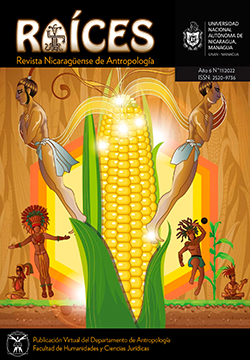Perceptions of the right to language in the Nahuas of Santa Ana Tlacotenco
DOI:
https://doi.org/10.5377/raices.v6i11.14484Keywords:
Right to language, Nahuas, Legal Realism, Critical Theory of LawAbstract
This article analyzes some perceptions that the Nahua community of Santa Ana Tlacotenco, Mayor´s Offi ce Milpa Alta, in Mexico City has regarding the right to language. This right as a positive Mexican right is not only interpreted from its legal understanding, but requires, in addition to the signifi cance of the originarl peoples, for the latter, the importance of this study. Knowing the perceptions that the Nahuas of Santa Ana Tlacotenco have regarding this right, establishes as one of the results that the rigth to language is understood by the actors of this research as a constitutional right that entails an asymmetric power relationship between the Satate Mexican and indigenous people; a right tha juridically appears to be neutral, but with which the power of the Satate continues to be strengthened over cultural assets such as the languages of minority groups; therefore, at the social level this right is perceived as a right with political content.Theoretically, this research is based on Legal Realism and Critical Theory of Law; and is characterized by being a qualitative study carried out during 2019 and 2020, whose database was built from semi-structured interviews and fi eld observations, which were analyzed through the Grounded Theory Method of Strauss and Corbin (2002).
Downloads
396
References
Bonetto, M. S., & Piñero, M. (1994). Teoría Crítica del Derecho. 63-71.
Campos, F. (Mayo-Agosto de 2010). Nociones fundamentales del realismo jurídico. Revista de Ciencias Jurídicas(122), 191-220.
Cienfuegos, D. (2005). Políticas y Derechos Lingüísticos. Refl exiones sobre la lengua y el derecho. México: Porrúa.
Constitución Política de los Estados Unidos Mexicanos. (2021)
Cruz, E., & Santana, M. (2014). ¿Reconocimiento jurídico de la diversidad cultural sin ejercicio de derechos? Pueblos y fronteras digital, 8(16), 218-255.
Desmet, C. (2007). Un estudio exploratorio de las actitides de estudiantes universitarios acerca de las lenguas indígenas y los derechos lingüísticos de sus hablantes en México. CELE (47), 73 96.
Durand Alcántara, C. H. (2005). Derecho indígena. Mexico: Porrúa.
Garzón, P. (2013). Pluralismo Jurídico. Eunomía. Revista en Cultura de la Legalidad (5), 186-193.
Hamel, R. (1995). Confl ictos entre lenguas y derechos lingüísticos: perspectivas de análisis sociolingüístico. ALTERIDADES, 5(10), 79-88.
Honneth, A. (Julio-Diciembre de 2006). El reconocimiento como ideología. ISEGORÍA, 129-150.
Hornberger, N. (1995). Escrituralidad, preservación de la lengua y derechos humanos lingüísticos: tres casos ilustrativos. ALTERIDADES, 5(10), 67-78.
INEGI, (2020). Ley General de los Derechos Lingüísticos de los Pueblos Indígenas. (2003)
Salazar, P. (2006). Democracia y (Cultura de la) Legalidad. México: Instituto Federal Electoral.
SEPI, (2021). Strauss, A., & Corbin, J. (2002). Bases de la Investigación Cualitativa. Técnicas y procedimientos para desarrollar la Teoría Fundamentada . Colombia: Universidad de Antioquia.
Valadés, D. (2010). La Lengua del Derecho y el Derecho de la Lengua. México: UNAM, Academia Mexicana de la Lengua.
Downloads
Published
How to Cite
Issue
Section
License
Copyright (c) 2022 © Universidad Nacional Autónoma de Nicaragua, Managua, UNAN-Managua

This work is licensed under a Creative Commons Attribution-NonCommercial-ShareAlike 4.0 International License.
This license enables reusers to distribute, remix, adapt, and build upon the material in any medium or format for noncommercial purposes only, and only so long as attribution is given to the creator. If you remix, adapt, or build upon the material, you must license the modified material under identical terms.




